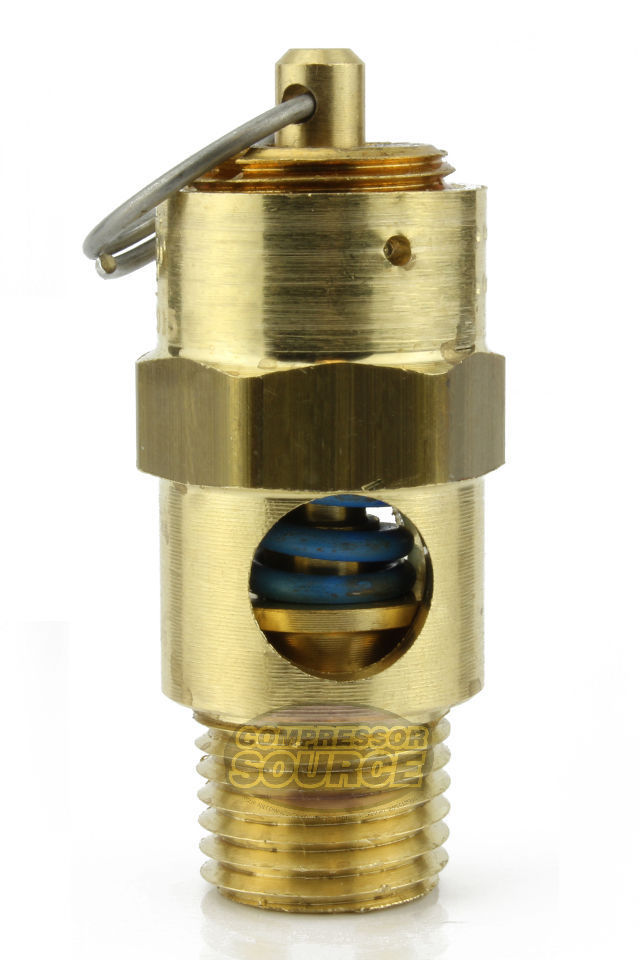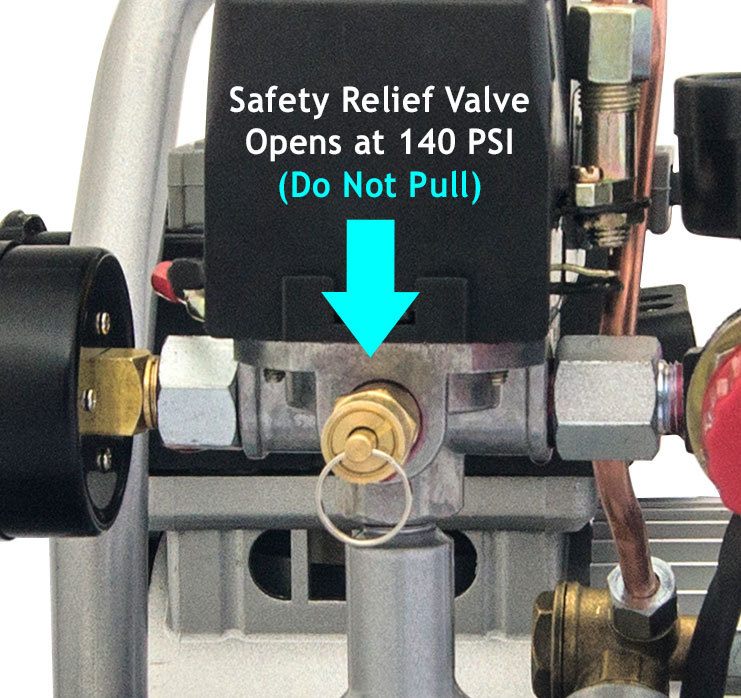An air compressor overpressure valve prevents excessive pressure buildup in the system. It ensures safety by releasing air when pressure exceeds preset levels.
Air compressors play a vital role in various industries, providing compressed air for tools and machinery. Safety is paramount when using these devices, as excessive pressure can lead to dangerous situations. The overpressure valve acts as a crucial safety feature, automatically releasing excess air to maintain safe operating levels.
This prevents potential damage to the compressor and minimizes the risk of accidents. Understanding the function and importance of this valve helps users ensure their equipment runs efficiently and safely. Regular maintenance and checks on the overpressure valve can significantly enhance the longevity and reliability of an air compressor.

Credit: www.reddit.com
Introduction To Air Compressor Safety
Air compressors are vital tools in various industries. They power equipment and streamline tasks. However, safety is a primary concern. Understanding how to maintain these machines prevents accidents. Proper safety measures protect both users and equipment.
Importance Of Air Compressor Maintenance
Regular maintenance keeps air compressors running efficiently. Neglecting maintenance can lead to serious issues. Here are key benefits of maintaining your air compressor:
- Improved Performance: Regular checks enhance efficiency.
- Extended Lifespan: Maintenance prolongs the life of equipment.
- Cost Savings: Preventive care reduces repair costs.
- Safety Assurance: Safe equipment lowers accident risks.
Follow a maintenance schedule. This ensures every part functions well. Keep the compressor clean and check for leaks.
Role Of Overpressure Valves
Overpressure valves are crucial for safety. They prevent excessive pressure buildup. Here’s how they work:
| Function | Description |
|---|---|
| Pressure Regulation | Maintains safe pressure levels in the system. |
| System Protection | Shuts down the compressor when pressure is too high. |
| Safety Assurance | Reduces the risk of equipment failure and accidents. |
Inspect overpressure valves regularly. Ensure they operate correctly. Replace faulty valves immediately to maintain safety.
Air Compressor Overpressure Valve Mechanics
The Air Compressor Overpressure Valve plays a crucial role in safety. It prevents excessive pressure build-up. Understanding its mechanics is essential for effective use.
How The Valve Works
The overpressure valve operates automatically. It opens when pressure exceeds a set limit. This action releases excess air to maintain safety.
- Pressure Monitoring: The valve constantly checks pressure levels.
- Activation: It activates once pressure crosses the threshold.
- Release Mechanism: The valve opens, allowing air to escape.
- Reset: Once pressure normalizes, the valve closes again.
Components Of The Overpressure Valve
Understanding the components helps in maintenance. The main parts include:
| Component | Function |
|---|---|
| Spring | Provides resistance to pressure. |
| Seat | Acts as a sealing surface. |
| Diaphragm | Translates pressure changes. |
| Body | Houses all components securely. |
Each component contributes to the valve’s function. Proper care ensures longevity and reliability.
Setting The Stage For Safety
Air compressors are vital in many industries. They power tools and machines. Safety is crucial when using these devices. The Overpressure Valve plays a key role in ensuring safe operation. It prevents excessive pressure buildup, protecting both equipment and users.
Regulatory Standards For Air Compressors
Various regulations guide air compressor safety. These standards ensure equipment operates within safe limits. Key organizations set these rules, including:
- Occupational Safety and Health Administration (OSHA)
- American National Standards Institute (ANSI)
- American Society of Mechanical Engineers (ASME)
These organizations publish guidelines that manufacturers must follow. Compliance with these standards helps prevent accidents. Regular inspections and maintenance are also required.
Compliance With Safety Protocols
Employers must ensure all workers follow safety protocols. This includes training on the proper use of air compressors. Here are essential compliance steps:
- Regularly inspect the Overpressure Valve.
- Conduct routine pressure tests.
- Ensure proper maintenance of equipment.
- Provide safety gear for operators.
Each step enhances safety in the workplace. Keeping records of maintenance and inspections is vital. These records can help during audits and inspections.
| Safety Protocol | Description |
|---|---|
| Inspection | Check all components regularly for wear and tear. |
| Maintenance | Perform routine servicing as per manufacturer guidelines. |
| Training | Educate employees on safe operational practices. |
Implementing these protocols creates a safer environment. An effective safety culture protects workers and equipment.

Credit: compressor-source.com
Installation Best Practices
Installing an air compressor overpressure valve correctly is crucial for safety and efficiency. Proper installation ensures reliable performance and prevents potential hazards. Follow these best practices for optimal results.
Correct Installation Techniques
Use these techniques for a successful installation:
- Read the Manual: Always refer to the manufacturer’s instructions.
- Use the Right Tools: Ensure you have all necessary tools ready.
- Check Compatibility: Verify the valve matches your compressor specifications.
- Clean Threads: Clean and inspect the threads for debris.
- Sealant Use: Apply thread sealant to prevent leaks.
- Torque Settings: Use the correct torque settings for tightness.
Following these techniques promotes a safe and effective installation process.
Common Installation Mistakes To Avoid
Prevent issues by avoiding these common mistakes:
- Neglecting the Manual: Skipping instructions leads to errors.
- Incorrect Size: Using the wrong valve size can cause failures.
- Over-tightening: This can damage threads and cause leaks.
- Ignoring Safety Precautions: Always prioritize safety during installation.
- Failing to Test: Always test the system after installation.
Staying aware of these mistakes helps ensure a smooth installation process.
Regular Inspection And Maintenance
Regular inspection and maintenance of your air compressor’s overpressure valve ensure optimal performance. This practice prevents costly repairs and enhances safety. A well-maintained valve operates smoothly, reducing the risk of pressure-related issues. Follow the guidelines below for effective inspection and maintenance.
Inspection Schedules
Establishing a clear inspection schedule is crucial. Here’s a simple guide:
- Daily: Check for any visible wear or leaks.
- Weekly: Inspect valve operation during compressor use.
- Monthly: Clean the valve and surrounding area.
- Quarterly: Conduct a pressure test on the valve.
- Yearly: Replace the valve if necessary.
Maintenance Procedures
Regular maintenance keeps your overpressure valve in top shape. Follow these procedures:
- Clean the Valve: Remove dirt and debris.
- Check Seals: Inspect rubber seals for damage.
- Test Functionality: Ensure the valve opens and closes smoothly.
- Adjust Pressure Settings: Follow manufacturer guidelines.
- Document Findings: Keep a record of inspections and repairs.
Consider using a table for your inspection records. This visual aid helps track maintenance effectively.
| Date | Inspection Type | Comments |
|---|---|---|
| 01/01/2023 | Monthly | Cleaned and tested valve functionality. |
| 01/02/2023 | Quarterly | Pressure test completed. No issues found. |
Regular inspection and maintenance of the overpressure valve guarantee safety and efficiency. Implement these schedules and procedures to protect your equipment.
Troubleshooting Overpressure Valve Issues
Dealing with overpressure valve issues can be frustrating. Understanding the signs of malfunction is crucial. Early detection can save time and money.
Identifying Signs Of Malfunction
Recognizing the signs of a faulty overpressure valve is essential for effective troubleshooting. Here are key indicators:
- Inconsistent Pressure Levels: Fluctuating pressure readings can signal a problem.
- Strange Noises: Hissing or popping sounds indicate possible leaks.
- Visible Damage: Look for cracks or corrosion on the valve.
- Frequent Shut-offs: The compressor stops running often due to pressure issues.
- Excessive Vibration: Unusual vibrations might suggest valve malfunction.
Steps For Troubleshooting
Follow these steps to troubleshoot overpressure valve issues:
- Turn Off the Compressor: Ensure safety first by switching off the unit.
- Inspect the Valve: Check for any visible damage or corrosion.
- Check Pressure Settings: Verify the pressure settings are correct.
- Test the Valve: Manually activate the valve to see if it opens and closes smoothly.
- Look for Leaks: Use soapy water to detect leaks around the valve.
- Replace if Necessary: If issues persist, consider replacing the valve.
Regular maintenance of your air compressor can prevent overpressure valve problems. Always consult the user manual for specific guidance.
Emergency Response Planning
Emergency response planning is crucial for any facility using air compressors. An overpressure event can cause serious damage. Proper planning ensures safety and quick action.
Preparing For Overpressure Events
Being prepared for overpressure events can save lives. Here are key steps to consider:
- Identify Risks: Assess where overpressure can occur.
- Install Safety Valves: Use reliable overpressure valves to prevent incidents.
- Regular Maintenance: Schedule maintenance for all equipment regularly.
- Monitor Pressure Levels: Use gauges to track pressure changes.
| Preparation Steps | Importance |
|---|---|
| Risk Assessment | Identifies potential hazards. |
| Safety Equipment | Prevents accidents and injuries. |
| Regular Checks | Ensures equipment is functioning well. |
Training Personnel For Emergencies
Training staff prepares them for emergency situations. A well-informed team can react quickly. Key training elements include:
- Emergency Procedures: Teach staff the steps to follow during an emergency.
- Equipment Handling: Ensure everyone knows how to operate safety valves.
- Drills and Simulations: Conduct regular practice drills to build confidence.
- Communication Protocols: Establish clear lines of communication during emergencies.
Regular training improves readiness. Staff must feel confident in their abilities. Use real-life scenarios to enhance learning.
Upgrading And Replacing Valves
Upgrading and replacing the air compressor overpressure valve can enhance safety and efficiency. A well-functioning valve prevents excess pressure. This protects your equipment and extends its lifespan.
When To Consider Upgrading
Recognizing the right time to upgrade is essential. Here are key indicators:
- Frequent pressure spikes.
- Visible corrosion or damage on the valve.
- Inconsistent pressure readings.
- Age of the valve exceeds 10 years.
Regular inspections help identify these issues early. Addressing them promptly can save money and downtime.
Selecting The Right Replacement
Choosing the correct replacement valve is crucial. Consider these factors:
| Factor | Description |
|---|---|
| Pressure Rating | Ensure it matches your compressor’s specifications. |
| Material | Choose durable materials like brass or stainless steel. |
| Size | Select a valve that fits your existing system. |
| Brand Compatibility | Opt for trusted brands for reliability. |
Research different options before making a purchase. Consult with professionals for advice. Proper selection ensures optimal performance.
Case Studies: Overpressure Valve Incidents
Understanding overpressure valve incidents can help prevent future failures. Analyzing past cases reveals common issues. These studies offer valuable lessons for safety and maintenance.
Analysis Of Past Failures
Multiple incidents of overpressure valve failures have occurred across various industries. Below are notable examples:
| Incident | Date | Cause | Outcome |
|---|---|---|---|
| Factory Explosion | 2018 | Valve malfunction | Severe damage; injuries reported |
| Pneumatic System Failure | 2020 | Improper maintenance | Production halt; financial loss |
| Oil Pipeline Burst | 2021 | Overpressure event | Environmental damage; costly repairs |
These incidents highlight critical issues in valve design and maintenance. The causes often stem from poor installation or inadequate inspections.
Learning From Real-world Scenarios
Understanding these failures helps improve safety measures. Here are key takeaways:
- Regular Inspections: Schedule frequent checks of overpressure valves.
- Proper Installation: Ensure valves are installed according to manufacturer guidelines.
- Training: Provide training for staff on valve operation and safety.
- Monitoring Systems: Implement technology to monitor pressure levels continuously.
Following these steps reduces the risk of future failures. Ensuring safety protects both people and property.

Credit: www.californiaairtools.com
Conclusion: Prioritizing Air Compressor Safety
Air compressors play a vital role in many industries. Ensuring their safe operation is crucial. One key component is the overpressure valve. This device prevents excessive pressure build-up. It protects both the equipment and the user.
Regular maintenance and inspections are essential. Understanding how the overpressure valve works can enhance safety. Operators must stay informed about potential risks. Prioritizing safety leads to efficient and safe operations.
Key Takeaways
- Overpressure valves prevent dangerous pressure build-up.
- Regular maintenance enhances safety and reliability.
- Knowledge of air compressor components is essential.
- Training for operators improves safety awareness.
- Follow manufacturer guidelines for best practices.
Future Outlook On Air Compressor Safety
The future of air compressor safety looks promising. Innovations in technology enhance safety features. Smart sensors can monitor pressure levels in real-time.
Training programs will become more advanced. Virtual reality simulations can prepare operators better. Industry standards will continue to evolve. Enhanced regulations will promote safer practices.
| Safety Aspect | Current Trend | Future Development |
|---|---|---|
| Overpressure Valves | Standard feature in most compressors | Smart valves with automated shut-off |
| Operator Training | Basic training programs | Advanced VR-based training |
| Regulations | Established safety guidelines | Stricter compliance requirements |
Frequently Asked Questions
What Is An Air Compressor Overpressure Valve?
An air compressor overpressure valve is a safety device. It prevents excessive pressure buildup in the compressor tank. When pressure exceeds a set limit, the valve opens. This action releases air, ensuring safe operation and protecting equipment from damage. Regular checks are essential for optimal performance.
How Does An Overpressure Valve Work?
The overpressure valve operates by monitoring pressure levels. It is calibrated to a specific limit. When pressure surpasses this limit, the valve activates and releases air. This process helps maintain safe pressure levels and prevents potential hazards. Proper functionality is crucial for the safety of your air compressor.
Why Is An Overpressure Valve Important?
The overpressure valve is vital for safety and efficiency. It protects the compressor from damage due to excessive pressure. This device prevents potential accidents and ensures compliance with safety regulations. Regular maintenance of the valve can prolong the life of your air compressor and enhance performance.
How To Maintain An Overpressure Valve?
Maintaining an overpressure valve involves regular inspections and testing. Check for any signs of wear or damage. Clean the valve to remove debris and ensure smooth operation. Additionally, ensure it is properly calibrated. Regular maintenance helps prevent failures and ensures the air compressor operates safely.
Conclusion
The air compressor overpressure valve is essential for safety and efficiency. It prevents damage and ensures optimal performance. Regular maintenance of this component can prolong the life of your compressor. Understanding its function helps you make informed decisions. Prioritize safety and efficiency for better results in your projects.

